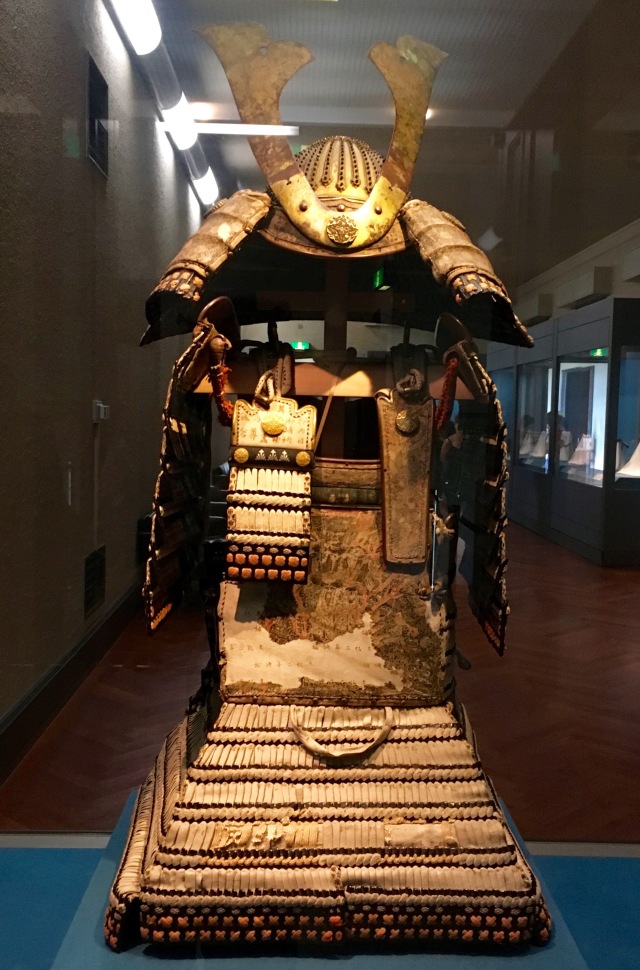By now, you know that I like to anchor myself in a new city by touching base with key historic and cultural antecedents. This usually means a museum or two, and I have found this is a great way to understand the place and the people a little bit better. Here in Japan, tourist shops selling owl key chains make more sense, for example, if you have seen an early terracotta owl in the museum and thus learned that owls are both considered protection from suffering as well as a symbol of education and wisdom. In addition, the fact that Japan was considerably shaped over its history by influence from both China and Korea puts a nuanced slant on the political events of the 20th and 21st centuries. (Plus, well, I just like museums because they usually have cool gift shops, reasonably priced cafes, and clean restrooms.) So early in my Tokyo stay, off I went to the Tokyo National Museum (TNM).

Selfie spot
From its brochure, I learned that the TNM has been open since 1872 and has the longest history of all museums in the country, comprised of over 116,000 objects. It is also not just the building pictured above, but rather is a complex of seven buildings and one gate (which is only open on weekends). The pictures in this post are a combination of the exhibits in the building seen above, the Honkan (which focuses on art) and a connected building, the Heiseikan (which features archeology.
On the way in, though, I spotted something I haven’t seen at any other of the multitude of museums I’ve visited, and that’s a parking lot for umbrellas. Says something pretty definitive about the weather in these parts (and a desire to keep the floors dry):

Not a dry eye in the house
So speaking of owls, here’s a clay figurine of one (on the left) and his friend, dating from sometime between 2000-1000 BCE:

“Whoooo’s on first?”
In my dotage, I have become much more interested in, and fascinated by, the artistry of peoples living the the bronze ages, which (depending on region) could be anywhere from 3000 BCE to 1000 BCE. The level of charm and sophistication of dozens of objects that I’ve seen over the past few years has been astonishing, and these are no exception. A little bit later in the game, now well into the CE, here is a variety of terracotta tomb figures, both human and not:

Designed to go the distance
Like in China, there was a long tradition of terracotta warrior guardians in Japan. (The Chinese warriors, I just learned, may actually have been inspired by the Greeks – see below):
http://www.livescience.com/41828-terracotta-warriors-inspired-by-greek-art.html
…which brings us to a newly revised version of one of my favorite historic motifs – the Silk Road (really a number of roads), but now extended *to Japan*:

You are here
…and with that in mind, here’s a shot of a drinking horn…that looks like a dead ringer for the ones I saw….in Georgia, which *I* can find in the map above between the Black and Caspian Seas. (Might not be so easy for you. Look due north of Saudi Arabia.)

“Gaumarjos!” er, “Kampai!”
No visit to a historical museum in Japan would be complete without acknowledgement of the role played by the samurai warrior class who ruled Japan for the better part of 700 years from the 12th through the 19th centuries. Here’s some armor from the 14th century:

Yikes
But before I scare you too much, I want to share that the museum has a beautiful garden behind it, open only for special occasions, although the rest of the time,we plebs can steal a peek. On a warm summer afternoon in the world’s largest metropolitan city, here’s a shot of peace and tranquility:

…and with that switch to a more peaceful setting, here’s a Buddha from the 13th century or so, Buddhism having arrived in the 6th century CE:

His “mudras,” or hand gesures, signal “harmony” in this sculpture.
That’s probably about enough history and culture for one day – I’ll bring you up closer to the present tomorrow with a story about my stroll around the Asakusa neighborhood, a charming reminiscence of the Edo period (17th-19th centuries). Until then, mata neh! (See you!)

Just as if I were there!
Nice pictures. How about more Japanese Garden pictures. Thanks.
Learn something new every day.
Lovely! I think I went to the Tokyo National Museum in 2011, but I can’t be sure. The samurai costume looks WOW!